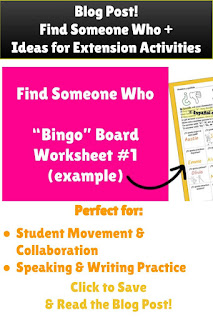Spanish Classroom Speaking, Listening & Writing Activities - Find Someone Who!
Spanish Classroom Speaking, Listening & Writing Activities - Find Someone Who!
One of my favorite activities to do in Spanish class that gets students out of their seats and conversing with their classmates, is a good ol’ Find Someone Who activity.
After talking with fellow colleagues about what this looks like in their classes, (even math teachers have done this activity!) I realized there’s many different variations of what this can look like depending on the subject, time of year, and grade level.
The most common time of year my colleagues were saying they use these activities is at the start of the school year, as an ice breaker activity. That’s definitely a great time to do an activity like this!
However, I’ve used this activity not just as a simple icebreaker activity, but with proper scaffolding & extension activities, it’s a great way to incorporate all 4 modes of communication!
Here’s my general multi-day lesson plan when it comes to using a Find Someone Who activity:
Familiarize students with relevant vocabulary ahead of time, unless you’re working with cognates.
Here are some topics I do this activity with:
Tener & Family Vocab
Gustar & Food
Seasons/Weather/Calendar Vocab
Verb Tenses
Pretérito
Holidays (Thanksgiving)
Weekend Chat
All students will have a Find Someone Who worksheet that looks like a Bingo board. Each box has a question.
Students will walk around the room, asking each other questions, responding, writing down the names of who answered “yes” to the question.
2 Ways to Play:
See who is the first to get 5-in-a-row, 4 corners, blackout
Have students ask each other the questions for 5-7 minutes, trying to fill out as much of their bingo board as possible.
All students will return to their seats and use the scaffolded sentence frames worksheet, write complete sentences about what they found out about their classmates using their Find Someone Who bingo board worksheet.
They’ll also pick 1 sentence from each section (usually that’s 3-4) and illustrate it to show their understanding of their sentences.
If there’s still time during this class period, do one of the extension activities.
Otherwise, over the course of the next few class periods, do 1-2 extension activities using both of their worksheets they worked on today!
I write about these extension activities in more detail within each of my downloadable resources, but here’s a brief list of how I incorporate more Speaking, Reading, Listening & Writing opportunities once both worksheets have been filled out.
1) The teacher can ask follow up questions verbally.(ejemplo: “¿A quién le gusta …? / ¿Quién va a …?)
Students can answer about themselves, or about their classmates.
After the teacher has modeled several times, students can take over as “teacher”.
2) The teacher can ask follow up questions about how many students xyz.
(ejemplo: “¿Cuántas personas van a …?”).
Students could raise their hand if it applies to them, or count aloud in Spanish.
The teacher can circle the vocabulary more, essentially narrating aloud what is visibly seen in the room (ejemplo: 6 people raised their hands, teacher narrates and says “Interesante, seis personas van a …”).
3) Have students get in a line.
Ask Yes/No questions and have students step to the left or right to indicate if they’re saying Yes or No to your questions.
The teacher can circle the vocabulary more, essentially narrating aloud who/how many people stepped to the left or right.
Depending on the topic and the students’ level, you can even add on follow up questions.
4) The teacher can make up True or False statements about classmates, and students have to listen & determine if they’re true or false.
Ask follow up questions if it makes sense.
5) If you have a document camera, or a way to take pictures of their drawings, upload and project this next activity can be so much fun! This is a great one to do on a following day, because it gives you time to snap pics on your phone and upload to Google Slides, or just to go through the pile and pick some of the most entertaining drawings. But! Don’t let that scare you off! I’ve totally done this activity during the same class with my document camera. It’s great for filling up those last few minutes of class too!
Show students’ drawings (I usually avoid showing their names because that can be distracting since students love roasting each other’s artwork, and that’s not the focus of this activity!)
Have students write sentences about the drawing; they could work with a partner and think-pair-share too!
Have students think-pair-share and verbally describe the drawings to an elbow partner.
Show 1 picture and 3-4 sentences and have students determine which sentence is describing the picture.
Of course, there are even more ways you can extend this activity!
I’d love to hear about your ideas in the comments!
Save this post for later!
Looking for more engaging & interactive activities for your Spanish class? Check out these posts for more!
Icebreaker Activity for Back to School
End of the Year No Tech Activities
My Students’ Favorite Review Game: The Unfair Game!
Looking for more tips & routines for setting up an amazing Spanish classroom? Check out these posts to find out more!
Setting a Classroom Routine with Map Partners
Improving Students Reading Comprehension and Writing Skills
.jpg)
%20(1).jpg)
%20(1).jpg)
%20(1).jpg)

.jpg)
